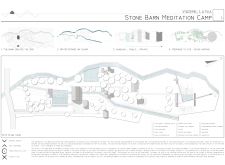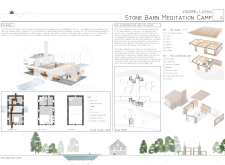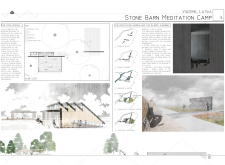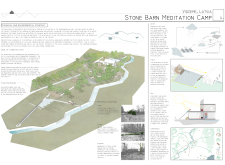5 key facts about this project
## Overview
The Stone Barn Meditation Camp, situated in Vidzeme, Latvia, is designed to facilitate spiritual and communal gathering. The project integrates architecture with the natural landscape, fostering a space conducive to meditation and collective experiences. Central to this implementation is the existing barn structure, which serves as a foundational element within the overall design scheme.
## Spatial Organization and Flow
A grid system is established by the barn, organizing various functional spaces throughout the site. This framework is further influenced by the existing topography and ecological features, such as water elements that create distinct zones transitioning from public to private areas. The layout is designed to guide users through a spiritual journey, with water features and gardens marking significant shifts between different spaces. This thematic arrangement resonates with local cultural symbols, enhancing the experiential qualities of the site.
## Materiality and Sustainability
The architectural approach emphasizes the use of locally sourced materials that align with ecological principles. Local stone is employed for structural components, creating a direct connection to the geology of the region. Additionally, timber sourced from nearby forests is utilized for lightweight construction and interior finishes, contributing to aesthetic appeal while minimizing environmental impact. Structural Insulated Panels (SIPS) are incorporated into the construction, providing energy efficiency and reducing the overall construction timeline, thereby lessening the disturbance to the natural landscape.
Specific features include an adaptive harvesting system that promotes agricultural engagement and a comprehensive water management system that collects rainwater for site use. This system not only supports the sustainability of the camp but also contributes to the serene atmosphere through reflective ponds, enriching local biodiversity. The architecture prioritizes sensitivity to local conditions, maximizing natural light and maintaining energy efficiency, while the design of dedicated meditation and reflection areas encourages solitude and engagement with the surrounding environment.






















































